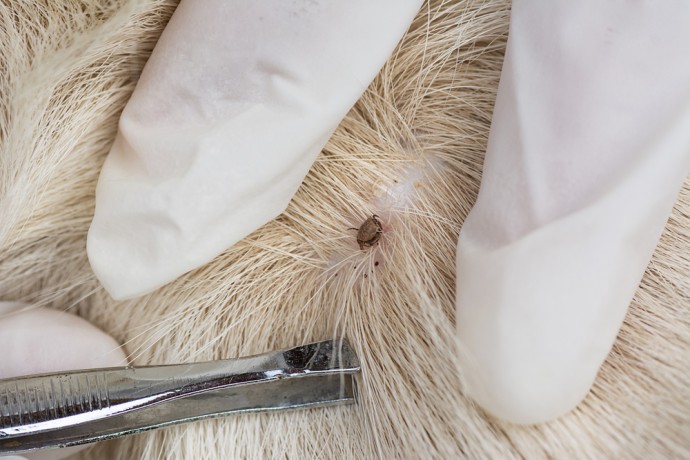Vet charity PDSA today reported a near-six-fold rise* in cases relating to Lyme Disease among UK pets in the last six years.

The worrying statistics mirror the worsening situation in humans, with surging numbers of people now diagnosed with the debilitating disease**.
Lyme Disease (Borreliosis) is caused by ticks – blood sucking parasites found in woodlands and long grass. It can lead to symptoms in pets such as fever, pain and swelling in the joints, crippling arthritis, nerve damage and even meningitis – which are similar to human symptoms.

PDSA saw around 100 cases of suspected or confirmed Lyme Disease in 2015 – an increase of 560% since 2009 (15 cases).
PDSA vet Vicki Larkham-Jones, warned that the figures were likely to be “just the tip of the iceberg” as many cases go unreported.
She said: “These figures are incredibly worrying because Lyme Disease can be a very serious, debilitating condition that can cause long-term problems if left untreated.
“Caught early, the disease can usually be effectively treated with long-term antibiotics. However, owners may not even be aware that their animal has been bitten by a tick, so they need to be vigilant.”
The rise in Lyme Disease in the UK, thought to be driven by climate change and warmer winters, has been recognised by public health officials for some time, according to NHS figures.
Reported human cases in England and Wales rose from 268 in 2001 to 959 in 2011*** (260% increase), but the true figure is thought be much higher.
Vicki Larkham-Jones added: “Although the tick population appears to be on the increase, the majority of these parasites do not cause Lyme Disease.
“We treated 2,545 pets for tick related issues****, including bites or removal in 2015 and only around 100 of these cases were suspected or confirmed cases of Lyme Disease.
“Now is the time for vigilance, as the UK’s tick population peaks between late spring and autumn.”
Thanks to funding from players of People’s Postcode Lottery, PDSA is educating pet owners on measures they can take to minimise the risk of themselves or their animal being bitten. The charity has produced a downloadable leaflet at www.pdsa.org.uk and is also delivering 300,000 parasite prevention treatments this year.
Tick-bite prevention tips from PDSA:
- Speak to your vet about prevention – as some flea treatments can also kill ticks
- Ticks are often found in wooded and moorland areas, especially in long grass. If Lyme disease is known to be a problem where you live, avoid letting your dog wander in deep undergrowth or grass, stick to paths
- Always wear long trousers tucked into socks or boots, and long sleeves to help protect yourself when walking in these areas too
- After walking your dog, always check for ticks. They can’t fly or jump, but they attach themselves to the skin of people or animals as they brush against them
- Tick bites don’t hurt so they aren’t always noticed. The most common areas for ticks on pets are the head, ears, legs and underside
- Hedgehogs and foxes are common tick carriers, meaning pets in urban areas with high fox populations are also at risk

Symptoms
- A small percentage of dogs that have been bitten by a tick will develop Lyme disease. It can cause a rash, a raised temperature, lack of energy, lameness, due to joint inflammation and swollen lymph nodes.
- When they first attach, a tick may be the size of a small pinhead but, as they suck blood, they can grow to the size of a match head and may look like a bluish-grey, pink or purple lump.

Treatment
- If you do spot a tick, on yourself or your pet, it must be removed properly as soon as possible. It is best to get advice from a vet before trying to remove a tick from your pet, as it’s easy to remove the body of the tick but the mouth can be left in the skin. If the tick isn’t properly removed it can cause an abscess or infection.
- Special tick tweezers are available to buy, but need to be used carefully, so speak to your vet or suitably qualified person for guidance before attempting to remove ticks with tweezers.
- Don’t crush or squeeze the tick’s body and don’t try and destroy the tick with a lighted match. Don’t put Vaseline on the tick as it may drop off but can still be alive to bite another victim
- The sooner you remove the tick the better – the risk of spreading disease increases the longer the tick is attached. Remember that Lyme disease is spread by infected ticks not from pet to person
Case study
Lakeland Terrier cross Brad, from Somercotes, Derbyshire, became extremely ill after contracting suspected Lyme Disease from ticks on a hedgehog in his owners’ garden.

Neil and Teresa Amos said their seven-year-old dog had found the hedgehog and when he came indoors he had several ticks attached to his muzzle and leg. Although Neil believed all of the ticks had been successfully removed the damage was already done as it seems Brad contracted Lyme Disease from one of the parasites.

He said: “A few weeks later I noticed Brad wasn’t himself at all. He would stand there almost looking straight through us and he couldn’t jump on and off the sofa.
“We’ve owned dogs all our lives and I’d heard about Lyme Disease so it automatically registered with me about the ticks and we took him straight to PDSA.”
Aimee Labbate, senior vet at PDSA’s Derby Pet Hospital, agreed that Brad was displaying classic symptoms of Lyme Disease.

She said: “Brad appeared to be very uncomfortable and was suffering joint pain. He seemed to have a hunched appearance and was having head tremors.
“We suspected he had Lyme Disease and prescribed a long course of antibiotics.”
After six weeks of medication Brad is making good progress.
Theresa added: “I would say he’s 100% back to his old self which is great. But he is one of the lucky ones. People don’t often realise how serious a tick bite can be but hopefully by highlighting Brad’s story we can help raise awareness among more pet owners.”
Searching for some travel inspo?
Check out our top dog-friendly hotels for 2021! But make sure you book soon as they’re quickly filling up…
 |
 |
 |
| The Arden Hotel, Warwickshire |

